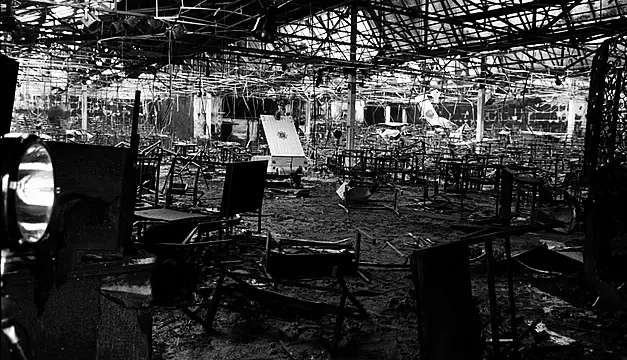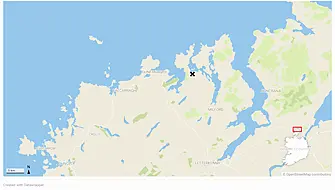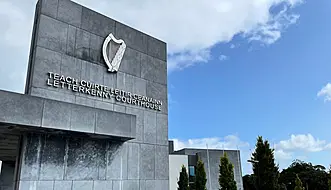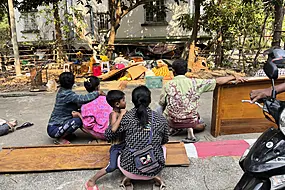An expert witness has told the Stardust inquest he believes a fire could have started in the hot press of the main bar without it being noticed by staff working there at the time.
Dr Will Hutchinson, a fire investigator and forensic scientist with 23 years' experience retained by coroner Dr Myra Cullinane, said if the fire originated in the hot press, it would have been contained in the cabinet and would have channeled upwards “like a chimney”.
He said the fire would have travelled into the ceiling void, so the heat and smoke would be gone and it could develop for a few minutes without making noise.
Dr Hutchinson concluded his evidence on Tuesday into the possible causes and origins of the fire which killed 48 people when it broke out in the Artane nightclub in the early hours of Valentine’s Day, 1981.
The witness told Patricia Dillon SC, on behalf of Dublin City Council, that the heat from the fire would have risen upwards straight through a missing tile in the corner of the bar.
Ms Dillon asked if the burning would have generated noise, had it been going on while people were working in the bar.
“Not necessarily,” Dr Hutchinson said.
Ms Dillon asked if it was a factor to be taken into account in assessing the “probability or otherwise” of such a fire taking place there, that there was “no complaint of smoke or comment about a fire”.
Dr Hutchinson explained that he believes it is sometimes possible to witness the start of a fire due to feeling heat or smelling smoke or hearing a noise. However, he said in this particular case, if the fire started in the cabinet, it would have been contained in the press and as a result, “the fire would channel upwards, rather like a chimney”.
The forensic scientist said the fire would travel into the ceiling void, the heat and the smoke “would be gone” and it could develop for a number of minutes without making noise.
The witness said the sound of music in the club may also have covered up any sounds coming from the cabinet.
“So I believe a fire could still develop in there at an early stage without it being noticed through the sound or the smell or the smoke,” he said.
The fire expert also pointed to the evidence of two glass washers who worked in the bar and who reported the smell of smoke and burning rubber before the fire was first noticed.
Earlier, Sean Guerin SC, for a number of the families of the victims, displayed a photograph of the hot press area taken on February 15th, the day after the fire, which shows a square-shaped tile missing in the corner as well as a number of other missing tiles.
He then showed another photograph which, he said, appears to have been taken on either February 20th or 24th.
Mr Guerin said the Garda investigation of the premises had finished by February 19th.
Mr Guerin said sometime over the course of the next five days, portions of the suspended ceiling tiles “appear to have been reinstated over the hot press”.
Dr Hutchinson confirmed that this was correct.
Asked by Mr Guerin if he knew why that happened, the witness said he did not.
Mr Guerin also addressed an issue relating to miniature circuit breakers (MCBs) in the hot press.
He said one of the early specialist examinations done on behalf of the gardaí noted that, when they went to examine the circuit boards where these MCBs were located, there had been some changes in the position of the MCBs from the position as they appeared in photographs taken by members of An Garda Síochána at an early stage following the fire. Dr Hutchinson confirmed this was correct.
He also agreed that it “wasn’t apparent” to those conducting the specialist examinations that there was any explanation for this having taken place and that the position of the circuit breakers was something that could potentially have been useful in terms of understanding how it was the fire had developed.
“That by identifying, for example which circuits had failed first it might be possible to reach a view as to where the fire had started?” Mr Guerin asked.
“Yes that's possible,” said Dr Hutchinson.
Dr Hutchinson confirmed to Seamus O’Tuathail SC, for the family of Marie Kennedy, one of those who died in the blaze, that gardaí at the time found no evidence to suggest that any person or persons were acting suspiciously in the West alcove and no evidence to suggest the fire was started maliciously.
He confirmed that this was in line with his own evidence.
“I’m just simply repeating that for the benefit of the jury at this stage because that is a worry among the relatives and parties here present including my client, that the idea that a fire started deliberately worries them,” said Mr O’Tuathail.
Dr Cullinane also put a number of questions to Dr Hutchinson on behalf of the jury, through their foreman.
The panel asked about previous evidence that a sudden increase in toxic gases took one and a half minutes. They asked if the one and a half minutes referred to just the West alcove or the entire ballroom.
Dr Hutchinson said the timeframe related to testing that was carried out the by the UK-based Fire Research Station (FRS) from a test rig which recreated the conditions in the West alcove.
He said the test rig replicated the West alcove where the gases were observed but pointed out that the smoke, which vented away in the experiment, would have had nowhere to go in the Stardust. He said as a result, the smoke would have rolled underneath the suspended ceiling and would have spread throughout the rest of the ballroom.
The jury then asked if the fire began in the hot press, how it had spread to the Store Room.
“So what we have is an ignition source at the hot press, the flames from that fire and the hot smoke produced from that fire would have vented upwards through the hole in the suspended ceiling,” explained Dr Hutchinson.
He said directly above that was one of the north lights which would have channeled all of the smoke and the fire upwards towards the ceiling.
In relation to what fuels were present, he said: “I know that there were PVC ducts present in the ceiling void, I know that there were rigid polystyrene grills within this suspended ceiling, but I don't know for certain what other combustible materials were up there other than a wooden lid on top of the cold water tank.”
Dr Hutchinson went on to say that “there must have been some fuel up there” because the fire continued into the ceiling void.
“Then through melted plastics or combustible material the fire found its way through that suspended ceiling to start a fire on one of the seats and that's what was visible inside the West alcove,” he said.
The fire expert said that once the fire took hold and made its way through into the West alcove, the suspended ceiling would have failed a short time later and all the hot gases and smoke would have started to collect in the ceiling void and would have travelled from East to West or West to East.
Dr Hutchinson said as the smoke continued to billow down it would have started filling up subsequent channels in the roof void and would have spread through the ignition of combustible material below the seats, the chairs and the rest of the combustible material allowing it to spread throughout the club.
He said he did not believe that it had travelled straight across via the top of the dispense bar to the Store Room because there was no damage above the dispense bar. He said he believed it had gone in a “more roundabout route”.
Asked by the jury why the fire did not travel across the suspended ceiling above the dispense bar, Dr Hutchinson said this was “purely down to geometry”.
He said as soon as the flames started spreading, hot gases would have spread from the top of the hot press through the hole in the suspended ceiling.
“Directly above that is part of the north light which would channel the fire in the opposite direction,” he said.
Finally, the jury noted that historical weather data records showed the outside temperature on the night was 1 degree Celsius between 1am and 2am.
They asked Dr Hutchinson to give his opinion on how this would affect the operation of the immersion heater if the roof space was exposed to this temperature.
The expert witness said he thought that ultimately, the temperature within the hot press cabinet would have been warmer than the 1 degree observed outside.
He said if it was colder inside the hot press cabinet then “perhaps” the immersion heater might have been trying to work a little bit harder to keep the water warm because of the missing cap on the end of the top immersion heater.
He said there was probably a “small factor” because it was cold outside but said he did not see it as a “significant factor”.
At the conclusion of Dr Hutchinson’s evidence, Dr Cullinane informed the jury that each of the legal representatives for the families who lost loved had instructed their own fire experts.
She said these experts had engaged with Dr Hutchinson in a very comprehensive way and it has been agreed that the legal representatives are satisfied for the jury to rely on the comprehensive presentation that they have had from Dr Hutchinson when it comes to the consideration of their findings.
The inquest continues on Wednesday.







